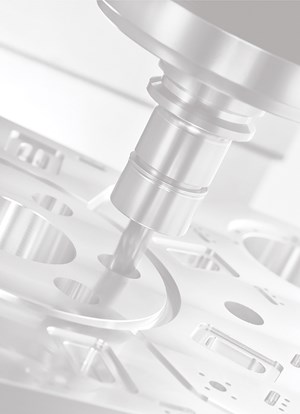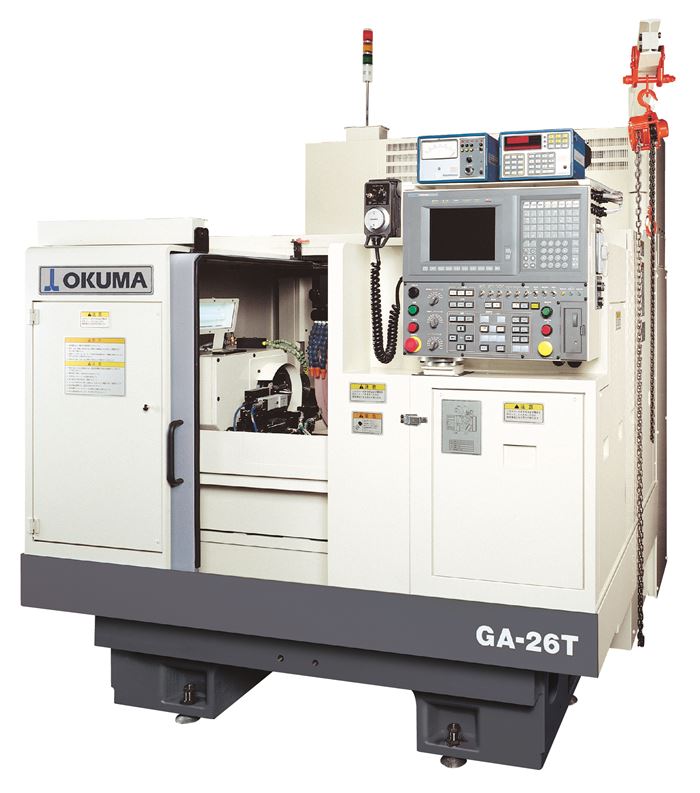Where Grinding Still Beats Hard Turning
For many critical applications, grinding remains the optimal machining process.
Share



Although advances in CNC turning centers and cutting tools have made substantial strides in favor of hard turning over grinding, grinding often turns out to be the better choice. That’s the position taken by Rob Titus, senior applications engineer—grinding products at Okuma America Corp. (Charlotte, North Carolina). Okuma is probably best known for its CNC lathes and machining centers. However, the company also offers a line of cylindrical OD and ID CNC grinders. With these interests in mind, the builder is always eager to find the best process for an application, whether it involves hard turning or grinding.
Mr. Titus points to the GA-26T OD grinder, shown recently at the 2012 International Manufacturing Technology Show (IMTS), as a representative example of grinding technology from Okuma. With automation provided by Gosiger Automation, the CNC grinder is designed for OD finishing of small- to medium-sized parts in high-volume production environments. To make the most of floor space, the grinder holds the workpiece stationary while the grinding wheel traverses back and forth. At the show, this grinder was equipped with in-process gaging, a wheel balancer and a 20-hp wheel spindle.
Mr. Titus frequently advises users on the merits of grinding versus hard turning. He says there are at least seven reasons to grind rather than hard turn:
1. Grinding excels at meeting surface finish, size and roundness requirements. A grinding process can achieve a 6 Ra surface finish, hold a size tolerance of less than 0.0002 inch and grind parts to within 30 millionths roundness.
2. Grinding provides a more cost-effective and stable process than turning for ceramic and carbide material. Hard turning carbides or ceramics requires diamond (PCD or CVD) inserts. Rapid wear and chipping of the inserts can result in size variation or scrapped parts. This adds downtime to change inserts and re-establish part size. In contrast, when grinding these materials with diamond-grit wheels, there is gradual wheel wear. The wheel can be dressed to expose new diamond grains without stopping production.
3. Grinding meets the “no lead” specification. This spec refers to the “spiral” visible on a turned shaft. It is created by a single-point cutting tool moving transversely as the part rotates on a lathe. This surface pattern can cause premature failure of seals on a shaft. By plunge grinding the shaft, the lead is eliminated.
4. Grinding is a common customer requirement. Automotive, aerospace and medical markets often specify a ground finish on critical parts.
5. Grinding wheels are not affected by interrupted cuts created by workpieces with features such as keyways or splines. Depending on the shape and size of these features, the interrupted cut can cause premature insert chipping in hard turning operations.
6. Grinding wheels cost less per part than other types of tooling. In some common cases, a grinding wheel can last 120,000 parts before it needs to be changed. If the cost of the wheel is $600, that’s a half a penny per part.
7. Grinding requires less downtime. How many times will an insert need changing on a CNC lathe throughout 120,000 parts?
Mr. Titus notes that most decisions about grinding or hard turning are not cut and dry. These decisions usually require expertise in both grinding and turning, he says, hence the value of consulting with Okuma, its distributor network or Partners in THINC consortium of technology providers. “We are certainly interested in raising the awareness that Okuma has a range of grinder models, but our primary concern is maximizing the user’s productivity and effectiveness,” he says.
Related Content
Inside a CNC-Machined Gothic Monastery in Wyoming
An inside look into the Carmelite Monks of Wyoming, who are combining centuries-old Gothic architectural principles with modern CNC machining to build a monastery in the mountains of Wyoming.
Read More10 Robotic Solutions You Can Find at IMTS 2026
Discover how today’s robots and cobots are making it easier than ever to automate tasks, free up skilled workers, and run machines unattended – even in small and midsized shops.
Read MoreA History of Precision: The Invention and Evolution of Swiss-Style Machining
In the late 1800s, a new technology — Swiss-type machines — emerged to serve Switzerland’s growing watchmaking industry. Today, Swiss-machined parts are ubiquitous, and there’s a good reason for that: No other machining technology can produce tiny, complex components more efficiently or at higher quality.
Read MoreAddressing Manufacturing Challenges with Automation
GrayMatter Robotics’ Physical AI robotic cells for manufacturing offer immediate impact and results.
Read MoreRead Next
OEM Tour Video: Lean Manufacturing for Measurement and Metrology
How can a facility that requires manual work for some long-standing parts be made more efficient? Join us as we look inside The L. S. Starrett Company’s headquarters in Athol, Massachusetts, and see how this long-established OEM is updating its processes.
Read More


















.png;maxWidth=300;quality=90)

 (1).png;maxWidth=300;quality=90)







